Port forwarding: how to set up virtual server on TP-Link Wi-Fi Routers
When you build up a server on the local network and want to share it on the internet, Virtual Servers can realize the service and provide it to internet users. At the same time Virtual Servers can keep the local network safe as other services are still invisible from the internet. Virtual Servers can be used for setting up public services on your local network, such as HTTP, FTP, DNS, POP3/SMTP and Telnet. Different services use different service ports. Port 80 is used in HTTP service, port 21 in FTP service, port 25 in SMTP service and port 110 in POP3 service. Please verify the service port number before the configuration.
I want to:
Share my personal website I’ve built in local network with my friends through the internet.

How can I do it?
Note: please check the model number of your TP-Link Wi-Fi router by referring to How to find the model number of your TP-Link device?
1. Assign a static IP address to your PC, for example, 192.168.0.100.
2. log in to the web management page by referring to How do I log into the web-based Utility (Management Page) of TP-Link wireless router?
3. Go to Advanced > NAT Forwarding > Virtual Servers.
4. Click Add. Click View Existing Services and select HTTP. The External Port, Internal Port, and Protocol will be automatically filled in. Enter the PC’s IP address 192.168.0.100 in the Internal IP field.
5. Click OK.
**Note: If you need to input a port range xx-xx when configuring the port forwarding, please leave the internal port empty.
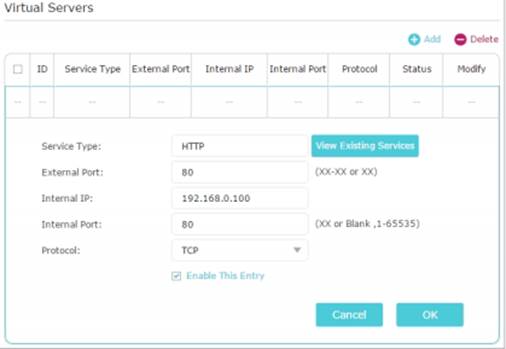
1). It is recommended to keep the default settings of Internal Port and Protocol if you are not clear about which port and protocol to use.
2). If the service you want to use is not in the Service Type, you can enter the corresponding parameters manually. You should verify the port number that the service needs.
3). You can add multiple virtual server rules if you want to provide several services in a router. Please note that the External Port should not be overlapped.
Done! Users on the internet can enter http:// WAN IP (in this example: http:// 218.18.232.154) to visit your personal website.
- The WAN IP should be a public IP address. For the WAN IP is assigned dynamically by the ISP, it is recommended to apply and register a domain name for the WAN. Then users on the internet can use http:// domain name to visit the website.
- For the CG-NAT ISP: Comporium and Direct link - radio service, provide the customer a private IP, that will cause you can’t use the OpenVPN or port forwarding and affect the NAT Type. You can contact the ISP and ask them to offer a Statis IP address.
- If you have changed the default External Port, you should use http:// WAN IP: External Port or http:// domain name: External Port to visit the website.
Note: please check the model number of your TP-Link Wi-Fi router by referring to How to find the model number of your TP-Link device?
1. Log into the router’s web management page:
How do I log into the web-based Utility (Management Page) of TP-Link wireless router?
2. Click Forwarding->Virtual Servers on the left side, and then click Add New… button.

3. Type the Service port which you want to open and the IP Address of your device that you want to open the port for; select Protocol to TCP, UDP or ALL; Change Status to Enabled.
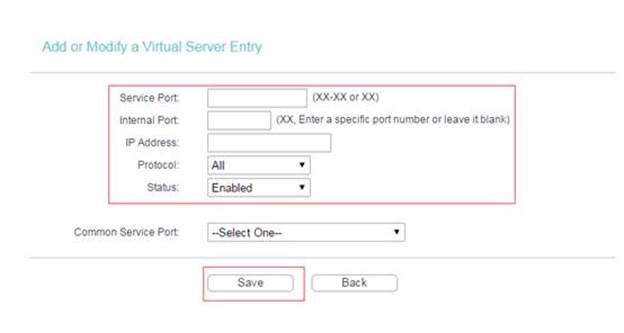
**Note: If you need to input a port range xx-xx when configuring the port forwarding, please leave the external port empty.
4. Click Save button to save the settings.
Note: You´d better assign a static IP address for your server, so the Virtual Server entry will take effect all the time. Or you can just do an IP address reservation for the server. Please refer to How to configure Address Reservation on TP-Link wireless router (new logo)?
5. Go to Status page and check the WAN IP Address of the router. Now you can try to use the WAN IP:Port Number to access the service from outside network.

If the WAN IP Address of the router is not a public IP Address, but a Private IP Address, that means there is another NAT device connected to the WAN Port of the TP-Link router, you need open the service ports on that device as well.
For how to find out the IP Address is a public one or private one, please refer to this link:
http://en.wikipedia.org/wiki/Private_network
Troubleshooting Tips:
A) If you want to open port 80 for a local device, please change the router’s remote management port (service port) number first since its default number is 80. As for internal port, 80 is reserved for the local management and cannot be modified although the remote management port has changed.

Go to Security-Remote Management, and then change the Web Management Port to other ports such as 8080 and Save.

B) Some models support different External Port (Service Port) and Internal port. Here we will explain this configuration under different situation.
For example, if you want to open the port 90 for only one of your device 192.168.1.106, you can configure it like below:
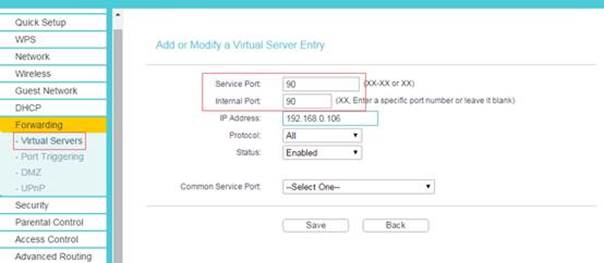
If you have two or more devices (192.168.1.106 &192.168.1.103 in this example) want the same port to be opened for a certain service, then you will have to use different External Ports (Service Port).
For the Internal Port, please put in the actual port number (90 in this example), then create different Service port numbers for the two devices (like 9000 and 9001 in this example).
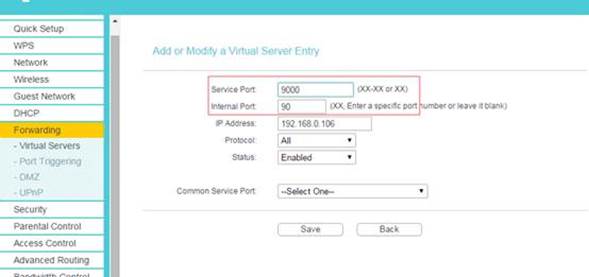
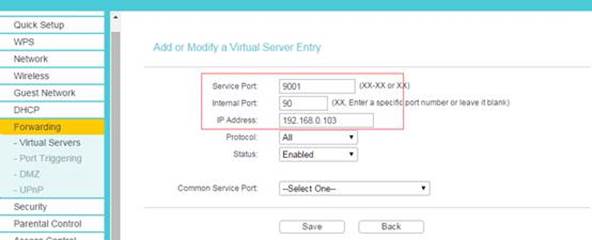
After these configuration, you can access the two devices using different External ports (Service Ports). In this case, you can use WAN IP:9000 to access 192.168.1.106 and WAN IP:9001 to access 192.168.1.103.
Get to know more details of each function and configuration please go to Download Center to download the manual of your product.
¿Es útil esta faq?
Sus comentarios nos ayudan a mejorar este sitio.